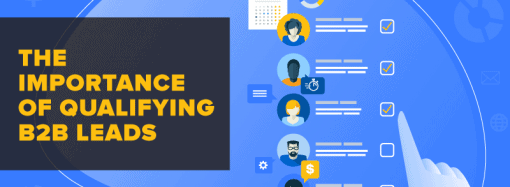What is a Marketing Creeper? Marketing Creepers are companies that use in-depth data to produce ads that creep out potential customers. Behavioral tracking data on potential customers has become a huge influence on integrated marketing efforts. From demographic information to interests, points of engagement, related activities, and more, the details of data you can gather
What is a Marketing Creeper?
Marketing Creepers are companies that use in-depth data to produce ads that creep out potential customers.
Behavioral tracking data on potential customers has become a huge influence on integrated marketing efforts. From demographic information to interests, points of engagement, related activities, and more, the details of data you can gather on a potential customer these days helps feed more information for marketers to know what they are interested in at the company, to what extent, and in turn, what might be the best approach or pitch to reach out to them with the greatest probability of conversion.
HOWEVER, data use for marketing has also started to creep customers out.
Take Amanda for Example:
Amanda was in the market for her first house. One evening, she was scanning websites for properties, looked at a few realtor listing sites and general listing sites. Next morning she gets a voicemail saying, “Hi Amanda. This is XYZ with XYZ Realty. I saw that you were on my website last night at 8:32pm looking at our listings in Americatown. I wanted to contact you IMMEDIATELY to see if I could help you with anything. Please call me. I’d like to help…with anything. Really, call me as soon as you can.”
Needless to say, Amanda did not feel like she was getting great treatment and attention related to her interests, but instead felt uncomfortable realizing that her actions on the website were being so closely monitored. Instead of calling the realtor back she decided to shy away from them and avoided their attempts to reach out.
So how can you use data efficiently, without being a creeper/stalker? The goal is to make sure you use the data to add value for your potential customers.
There are a few ways to use this data efficiently, without really revealing to your customers that you’re tracking them and delivering value to increase their probability of turning into sales:
Lead Nurturing

Using your data, you can deliver the right content, at the right time and with the right channel to generate the highest probability of conversion. This is where marketing automation comes in as a saving grace –a pointed source for gathering this data, usually integrated with CRM systems, and a means to communicate this targeted content.
Take Amanda for Example:
Amanda probably would have felt a bit less creeped out about the realtor having that kind of information on her if she had instead received a much less overbearing touchpoint and with the right type of information she needed. For example, it would have been much more appropriate to send a follow up email with:
a) Information that further detailed something she was looking at, or
b) A downloadable infosheet on “Steps to Purchase Your First Home”
Amanda was just beginning her search for a home. Having either (a) more on the product/service she was interested in or (b) info she could definitely use at this stage in the buying process would have both benefited her well and would have made her feel more comfortable and willing to engage with XYZ Realty.
Target Leads Socially

Whichever platform works for your type of company the best (Facebook, LinkedIn, or both), they each offer targeting based on user information such as gender, age, job position, salary, interests, industries, company size, marital status, their own connected friends or colleagues, or even direct contact (based on data you’ve already gathered on that person).
Talk about getting your information in front of the right people, whether they already realize they need your product/service or not.
Take Amanda for Example:
Mister XYZ, using direct contact info and/or social filters, could have targeted Amanda with an ad in her Facebook news feed that said something about XYZ Realty being one of the most trusted real estate agencies in Americatown for first time home buyers. She would then notice that her friends Nancy and Tom both like XYZ Realty. She might think, “Hey, I looked at this website before. They must be pretty reputable. My friends seem to think so.”
Mister XYZ could have also done this on LinkedIn, with that infosheet we previously mentioned being sent directly to Amanda, presented as a side ad or represented in a sponsored update that appears in her LinkedIn homepage feed. Using these methods could have indirectly offered more information from the company and enhance the likelihood of Amanda’s engagement with XYZ Realty with less stalker feelings than the voicemail she had received.
Remarketing: Burning the Brand into Their Brain
A third method to use your data efficiently is through remarketing (or retargeting) techniques. You may have heard this term thrown around a few times but haven’t quite fully grasped its meaning. Well, have you ever visited a company’s website, then after that noticed banner ads for that company appearing everywhere you went on the web? Whether reading news, researching something, or just browsing your usual interests, you keep noticing that there are banner ads on display for the company website you once visited.
What a weird coincidence… or not. That is remarketing. Using tracking through cookies and banner ads entered into Google AdWords’ remarketing tool, you can get your company continuously displayed in front of previous visitors to your website. This helps remind them of your company and build their awareness of you, making them more likely to click the ad and go back to your website and convert to a potential sale.
Take Amanda for Example:
XYZ Realty could have started using remarketing. After Amanda left their website, instead of the stalker-like phone call, XYZ could have relied on remarketing to get XYZ Reality in front of Amanda. She might go to the New York Times and read some news pieces and notice an ad for XYZ Realty; she might visit her favorite recipe site for her dinner plans that night and find another ad for XYZ Realty; she might be researching information on getting a home loan and see yet another ad for XYZ Realty.
After seeing these ads she might realize, “I still need to find to find a house. Oh look, there’s an ad for XYZ Realty. I remember visiting their website. They had good listings. I should click and go back and look some more.” There’s your potential new client.
What’s great is that these actions don’t have to act alone! Say you implemented remarketing and then later sent an email with information relevant to that potential lead. The built up awareness of your company through remarketing helps justify your email information even more with that potential lead. They will recognize you and see value in what you are offering them, making them more likely to do business with you.














